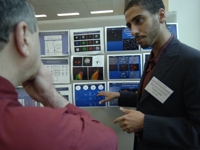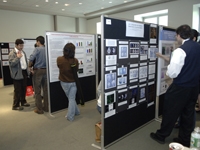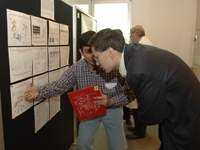
Graduate Student Yosif Ganat discusses his experiments in polysialic acid (PSA).
Judging by the number of participants, the 26th Annual du Vigneaud Symposium was verging on being too successful.
"We actually had to go out at the last minute and rent additional display boards to accommodate all of the poster presentations," symposium co-organizer Chad Shelton said. Two late additions to the program brought the total number of projects to 113, the highest in the event's history, with students from the Weill Cornell Graduate School, The Rockefeller University and Cornell University in Ithaca contributing to the day-long event.
"Students enjoy participating in the symposium because it is one of the few times throughout the year that the college comes together and celebrates the research of students," Shelton said. The research projects are typically undertaken in each student's thesis lab, where they work with faculty advisors to develop original research that contributes to their lab's overall goals.

Student poster sessions carried on throughout the afternoon.
The event is named for Dr. Vincent du Vigneaud, the former head of biochemistry at Cornell University Medical College (as it was called in 1938) whose synthesis of oxytocin opened a new area in protein organic chemistry and earned him the 1955 Nobel Prize in Chemistry.
In its 26th year, du Vigneaud's namesake symposium is an opportunity for students to formally present their work to colleagues and faculty judges in a competitive environment, with top researchers earning coveted du Vigneaud Prizes and other significant projects earning Awards of Excellence and First-Year Awards. The event not only celebrates the work of students, but is also entirely student-organized and student-run.
"We are very proud that this symposium is organized by the student body," Dr. David Hajjar, dean of the Weill Cornell Graduate School of Medical Sciences, said. "The du Vigneaud Symposium is an important event for the Graduate School not just because of the student research, but because the students alone give presentations in poster and large-group oral presentations. This is what they will be doing for the rest of their career."

Graduate Student Ali Yunus explains his study "Structural and Functional Analysis of E2-Mediated Conjugation in the Sumo Pathway."
The poster-board sessions were held in the portrait gallery of Rockefeller Research Labs, with students describing their research in a series of sessions throughout the day. Twelve students also gave oral presentations in the Rockefeller Research Lab Auditorium, an opportunity extended to students only once during their term as graduate students. Following each presentation, students had to field questions from the audience and defend their research, a process that mirrors the presentations they will provide at scientific congresses and symposia throughout their careers.
"The importance of presenting is tremendous, because the ability to present research in a logical, concise and exciting way is, for many of us, an acquired skill," said Branka Stancevic, a co-organizer of the event and member of the du Vigneaud committee for the past two years.
The symposium also forces students to rethink the nature of their research, and their long-term goals. "It is very easy to get lost in the small details and day-to-day tasks of experiments, and often we forget the goal of the project. But du Vigneaud also helps student look at the big picture of their project," said Stancevic.
For this year's symposium, the student body selected world-renowned stem cell biologist Dr. Irving Weissman as the keynote speaker, a choice that reflects the emergence of stem cells as a novel therapeutic and a politically popular issue. During his address, Dr. Weissman discussed the need to focus on the science of stem cells—not the commercial or political aspects—and outlined the history of his lab's identification and isolation of blood-forming stem cells in mice.
"In his position as one of the 'founding fathers' of stem cell research, he is active in the political side, not just the science," said Shelton. "The breadth of his experience extends beyond his academic pursuits, beyond science, into philosophy and religion."
Ultimately, though, it was the students' work that carried the day. The symposium awards were announced during a reception and awards ceremony at Griffis Faculty Club with du Vigneaud prize-winning projects representing diverse fields, from the synthesis of stereochemically novel organic compounds to a better understanding of pathogens like E. coli and M. tuberculosis that affect global health.
du Vigneaud Prizes
Justin Potuzak
Omar Vandal
Ram Madabhushi
Ali Yunus
Piraye Yurttas
Muris Kobaslija*
Andrea Hooper

Graduate Student T.L. Benedetto talks about her study on prenatal cocaine exposure with Dr. Gunnar Gouras.
Awards of Excellence
Joseph Mancias
Carl Wonders
Andrea Anantharam
Sheetal Gandotra
Jayakrishnan Nandakumar
Ann Gregus
Guocan Wang
Jeanne Farrell
Rjeshwari Valiathan
Cristina Fernandez
Dan Su
First-Year Awards
Karl Merrick
Taya Feldman
Eleanor Allen
*Cornell University (Ithaca)
Photos by Amelia Panico.

